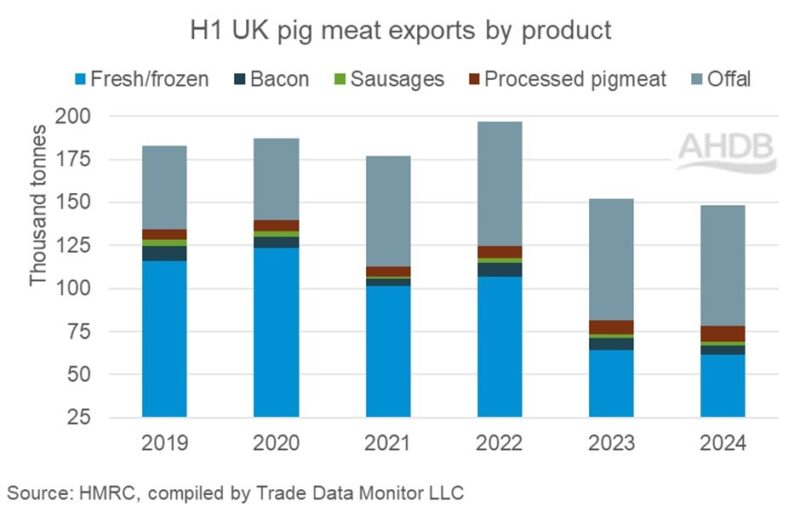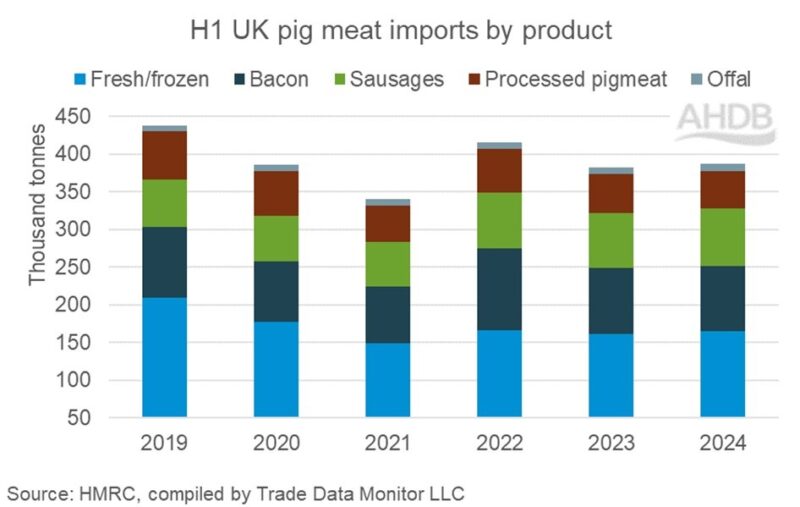UK pigmeat exports dropped to their lowest level for nine years in the first six months of this year, while imports increased, HMRC figures show.
In June, pigmeat exports were up 4% year-on-year, at 25,100 tonnes, driven by increased shipments of offal (12,300 tonnes) and fresh/frozen product (10,100t).
Although this is the second month of year-on-year growth (with April also seeing volume gains of 4%), larger declines in January, March and May have resulted in an overall 2.4% decline in shipments in the first half of the year. The cumulative six-month figure of 148,200t was the lowest since 2015.
The year-to-date volume decline is being driven by two product categories, fresh/frozen and bacon, losing 2,500 tonnes and 1,900 tonnes, respectively, according to AHDB senior analyst Freya Shuttleworth.

Offal volumes have been steady year-on-year, continuing to hold the largest market share, at 47%), while processed pig meat and sausages have made small gains.
“UK exports have witnessed some challenges this year, with tight domestic supplies resulting in higher product pricing compared with other players on the global market, such as the US and Brazil,” Ms Shuttleworth said.
“With consumers globally still wary of their spending amid higher cost of living, affordability is a key market driver in regions such as China.”
Looking ahead, she added: “Increasing geopolitical tensions make work on gaining greater market access for UK products a key priority to maintain carcase balance and value across the whole supply chain.”
Imports
Imports of pig meat to the UK were also up 4% year-on-year in June to 71,000t, with gains across all categories. Fresh/frozen product continues to make up most of the import basket at 29,800 tonnes – however sausages overtook bacon volumes to stand at 16,100t and 14,800, respectively.
Overall, imports in the first six months of the year have grown by 1.4% compared with 2023 to 387,500t.
However, growth has not been universal across product categories. Import volumes of processed pigmeat and bacon have fallen, down 3,100t and 1,800t, respectively. While fresh/frozen product holds the largest market share at 165,100 tonnes, the sausage category has made the largest gain year-on-year, up 5,300 tonnes to 77,600 tonnes.

Ms Shuttleworth added: “Despite overall GB pork volume sales declining year on year (-1%, 52 weeks ending 09 June, Kantar), there is a large difference between retail trends and foodservice.
“The overall decline is driven by retail losses as it is a considerably larger market. However, with most major retailers continuing to uphold their British product commitments, there is generally less reliance on imports within this sector.
“Foodservice (which includes eating out and takeaways) on the other hand, relies more heavily on imports with less transparency on product/ingredient sourcing.
“The price differential between the UK and the EU has widened significantly in the first half of 2024 compared to 2023, leading some to view EU product as more attractive on a cost basis. Paired alongside this, a weakening euro is also likely to have encouraged some buyers to look at the continent.
“There remain some key demand challenges both domestically and globally. Although price inflation has eased, average prices paid by consumers have risen.
“Domestic import demand will likely continue to see some volatility in the coming months with buyers closely following movements in price differentials, exchange rates and wider economic indicators.”




